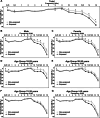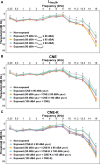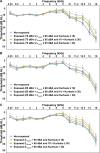Association of Occupational Noise Exposure and Extended High-Frequency Hearing Loss in Young Workers With Normal Hearing
- PMID: 39726114
- PMCID: PMC11984550
- DOI: 10.1097/AUD.0000000000001618
Association of Occupational Noise Exposure and Extended High-Frequency Hearing Loss in Young Workers With Normal Hearing
Abstract
Objectives: Studies on the relationship between occupational noise exposure and extended high-frequency (EHF) hearing loss are limited. This study investigated the relationship between occupational noise exposure and EHF hearing loss in workers exposed to noise as measured by sound pressure level, exposure duration, and kurtosis to help provide a basis for early detection and prevention of hearing loss in noise-exposed workers.
Design: A cross-sectional survey was conducted among 602 participants with 472 noise-exposed workers and 130 non-noise-exposed controls. General demographic characteristics, noise exposure data, and hearing thresholds at conventional frequencies (0.25 to 8 kHz) and EHF (9 to 16 kHz) were collected and analyzed. Linear mixed-effects model analyses between hearing thresholds of EHF and noise exposure indicators including the 8-h equivalent continuous A-weighted sound pressure level ( LAeq,8h ), cumulative noise exposure (CNE), and kurtosis-adjusted CNE (CNE-K) were conducted.
Results: Among the 602 participants included in the analysis, 472 individuals (78.4%) were occupationally exposed to noise exposures ≥75 dBA. Significant differences ( p < 0.05) were observed in sex, exposure duration, LAeq,8h , CNE, and CNE-K between the noise-exposed group and the nonexposed group. The mean hearing thresholds for all tested extended high frequencies ranging from 9 to 16 kHz were significantly higher in the noise-exposed group than in the nonexposed group ( p < 0.05). The mean hearing thresholds of subjects in different groups of LAeq,8h exposures were generally stable with little variance in the conventional frequencies (0.25 to 8 kHz) but differed in the EHF range. Moreover, EHF hearing loss appeared to be most prominent in the subjects exposed to noise with 80 dBA < LAeq,8h ≤ 85 dBA. After the combination of the sound pressure level, exposure duration, and kurtosis by using the noise exposure indicators CNE and CNE-K, the subjects at the different noise exposures showed significant differences in hearing thresholds at EHF ( p < 0.05). Linear mixed-effected model analyses showed that the CNE-K was the best to indicate noise-induced hearing loss among the three noise exposure indicators at EHF.
Conclusions: The results indicate that the EHF hearing threshold testing is more sensitive to identifying early occupational noise-induced hearing loss than conventional audiometry. The CNE-K, an indicator combining noise energy, exposure duration, and kurtosis, is a more comprehensive and effective method for assessing the risk of EHF hearing loss due to occupational noise exposure.
Keywords: Complex noise; Cumulative noise exposure; Extended high-frequency audiometry; Kurtosis; Noise-induced hearing loss; Occupational noise exposure.
Copyright © 2024 The Authors. Ear & Hearing is published on behalf of the American Auditory Society, by Wolters Kluwer Health, Inc.
Conflict of interest statement
The authors have no conflicts of interest to disclose.
Figures



Similar articles
-
Effectiveness of Kurtosis-Adjusted Cumulative Noise Exposure in Assessing Occupational Hearing Loss Associated With Complex Noise.Ear Hear. 2023 Jul-Aug 01;44(4):865-876. doi: 10.1097/AUD.0000000000001327. Epub 2023 Jan 11. Ear Hear. 2023. PMID: 36629325 Free PMC article.
-
Applying Kurtosis as an Indirect Metric of Noise Temporal Structure in the Assessment of Hearing Loss Associated With Occupational Complex Noise Exposure.Ear Hear. 2021 Nov-Dec 01;42(6):1782-1796. doi: 10.1097/AUD.0000000000001068. Ear Hear. 2021. PMID: 34369415 Free PMC article.
-
The role of kurtosis and kurtosis-adjusted energy metric in occupational noise-induced hearing loss among metal manufacturing workers.Front Public Health. 2023 Jun 29;11:1159348. doi: 10.3389/fpubh.2023.1159348. eCollection 2023. Front Public Health. 2023. PMID: 37457253 Free PMC article.
-
Occupational Hearing Loss Associated With Non-Gaussian Noise: A Systematic Review and Meta-analysis.Ear Hear. 2021 Nov-Dec 01;42(6):1472-1484. doi: 10.1097/AUD.0000000000001060. Ear Hear. 2021. PMID: 34010248 Free PMC article.
-
A review of the perceptual effects of hearing loss for frequencies above 3 kHz.Int J Audiol. 2016 Dec;55(12):707-714. doi: 10.1080/14992027.2016.1204565. Epub 2016 Jul 14. Int J Audiol. 2016. PMID: 27414746 Review.
Cited by
-
A Simple Nomogram for Predicting Extended High-Frequency Hearing Loss in Pilots Despite Normal Audiometry: A Retrospective Study.Noise Health. 2025 Mar-Apr 01;27(125):112-122. doi: 10.4103/nah.nah_188_24. Epub 2025 Apr 29. Noise Health. 2025. PMID: 40298050 Free PMC article.
References
-
- Agrawal Y., Platz E. A., Niparko J. K. (2008). Prevalence of hearing loss and differences by demographic characteristics among US adults: Data from the National Health and Nutrition Examination Survey, 1999-2004. Arch Intern Med, 168, 1522–1530. - PubMed
-
- Ahmed H. O., Dennis J. H., Badran O., Ismail M., Ballal S. G., Ashoor A., Jerwood D. (2001). High-frequency (10-18 kHz) hearing thresholds: Reliability, and effects of age and occupational noise exposure. Occup Med (Lond), 51, 245–258. - PubMed
-
- Ahroon W. A., Hamernik R. P., Davis R. I. (1993). Complex noise exposures: An energy analysis. J Acoust Soc Am, 93, 997–1006. - PubMed
-
- American National Standards Institute. (2018). ANSI/ASA S3.6: Specification for Audiometers. Acoustical Society of America.
-
- American Speech-Language-Hearing Association. (2005). Guidelines for manual pure-tone threshold audiometry, 20, 297–301. https://www.asha.org/policy/GL2005-00014 - PubMed
MeSH terms
Grants and funding
LinkOut - more resources
Full Text Sources
Medical

